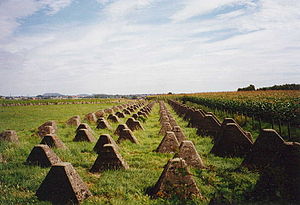
A caltrop is an area denial weapon made up of two or more sharp nails or spines arranged in such a manner that one of them always points upward from a stable base. Historically, caltrops were part of defences that served to slow the advance of troops, especially horses, chariots, and war elephants, and were particularly effective against the soft feet of camels. In modern times, caltrops are effective when used against wheeled vehicles with pneumatic tires.

The Siegfried Line, known in German as the Westwall, was a German defensive line built during the late 1930s. Started in 1936, opposite the French Maginot Line, it stretched more than 630 km (390 mi) from Kleve on the border with the Netherlands, along the western border of Nazi Germany, to the town of Weil am Rhein on the border with Switzerland. The line featured more than 18,000 bunkers, tunnels and tank traps.
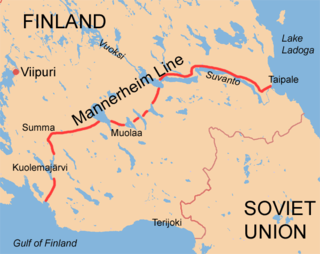
The Mannerheim Line was a defensive fortification line on the Karelian Isthmus built by Finland against the Soviet Union. While this was never an officially designated name, during the Winter War it became known as the Mannerheim Line, after Finnish Army's then commander-in-chief Field Marshal Baron Carl Gustaf Emil Mannerheim. The line was constructed in two phases: 1920–1924 and 1932–1939. By November 1939, when the Winter War began, the line was by no means complete.
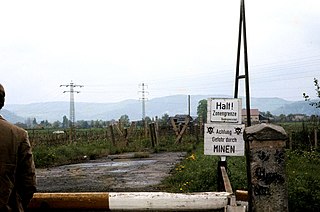
An area denial weapon is a defensive device used to prevent an adversary from occupying or traversing an area of land, sea or air. The specific method may not be totally effective in preventing passage, but is sufficient to severely restrict, slow down, or endanger the opponent. Some area denial weapons pose risks to civilians entering the area even long after combat has ended, and consequently are often controversial. An area denial weapon can be part of an anti-access/area denial (A2/AD) strategy.
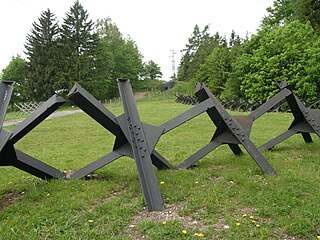
The Czech hedgehog is a static anti-tank obstacle defense made of metal angle beams or I-beams. It is similar in shape to a much larger version of metal knucklebones or caltrops. The hedgehog is very effective in keeping light to medium tanks and vehicles from penetrating a line of defense; it maintains its function even when tipped over by a nearby explosion. Although Czech hedgehogs may provide some scant cover for attacking infantry, infantry forces are generally much less effective against fortified defensive positions than mechanized units.
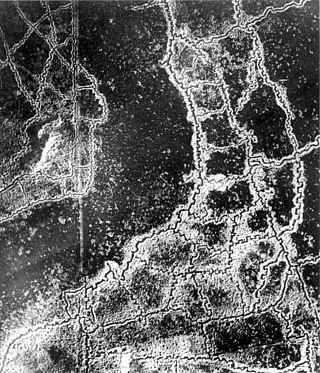
No man's land is waste or unowned land or an uninhabited or desolate area that may be under dispute between parties who leave it unoccupied out of fear or uncertainty. The term was originally used to define a contested territory or a dumping ground for refuse between fiefdoms. It is commonly associated with World War I to describe the area of land between two enemy trench systems, not controlled by either side. The term is also used metaphorically, to refer to an ambiguous, anomalous, or indefinite area, regarding an application, situation, or jurisdiction. It has sometimes been used to name a specific place.

Melitopol is a city and municipality in Zaporizhzhia Oblast, southeastern Ukraine. Melitopol has been under Russian control since March 2022. On September 30, 2022, the city was formally annexed by the Russian Federation; however, it remains internationally recognized as sovereign territory of Ukraine. It is situated on the Molochna River, which flows through the eastern edge of the city into the Molochnyi Lyman estuary. Melitopol is the second-largest city in the oblast after Zaporizhzhia and serves as the administrative centre of Melitopol Raion.

The Toblerone line is a 10 km long defensive line made of "dragon's teeth" fortifications built during the Second World War between Bassins and Prangins, in the Canton of Vaud, Switzerland. These lines of defensive blocks can be found all over Switzerland, though more commonly in border areas. Their purpose was to stop tank invasions. The 2,700 9-ton concrete blocks that make up the defences are similar to the shape of the Toblerone chocolate bar, which gave its name to the line. Since the line has been left to nature since its construction, it was decided to keep these concrete blocks and to make a hiking trail along their route.
The Mius-Front was a heavily fortified German Nazi defensive line along the Mius River in the Donbas region of the Soviet Union and Ukraine during World War II.
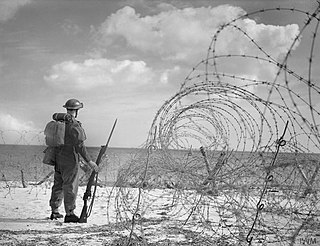
British anti-invasion preparations of the Second World War entailed a large-scale division of military and civilian mobilisation in response to the threat of invasion by German armed forces in 1940 and 1941. The British Army needed to recover from the defeat of the British Expeditionary Force in France, and 1.5 million men were enrolled as part-time soldiers in the Home Guard. The rapid construction of field fortifications transformed much of the United Kingdom, especially southern England, into a prepared battlefield. Sea Lion was never taken beyond the preliminary assembly of forces. Today, little remains of Britain's anti-invasion preparations, although reinforced concrete structures such as pillboxes and anti-tank cubes can still be commonly found, particularly in the coastal counties.

A mine-clearing line charge is a device used to create a breach in minefields under combat conditions. While there are many types, the basic design is for many explosive charges connected on a line to be projected onto the minefield and then exploded, detonating any buried mines, thus clearing a path for troops to cross.
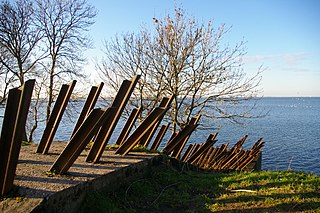
Anti-tank obstacles include, but are not limited to:

A pillbox is a type of blockhouse, or concrete dug-in guard-post, often camouflaged, normally equipped with loopholes through which defenders can fire weapons. It is in effect a trench firing step, hardened to protect against small-arms fire and grenades, and raised to improve the field of fire.

The Kiev Fortified Region is a fortified district in the Kiev area, a complex of defensive structures, consisting of permanent and field fortifications and engineering obstacles. It was built in the period from 1929 to 1941 for the protection of the old border of the USSR. The total length of the fortified region is about 85 km between the flanks, which are anchored on the river Dnieper, and the depth of the defensive zone ranges from 1 to 6 km.

A fortified district or fortified region in the military terminology of the Soviet Union, is a territory within which a complex system of defense fortifications was engineered.
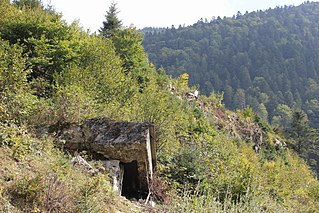
The Árpád Line was a line of fortifications built in 1941-44 in the north-eastern and eastern Carpathian Mountains, along the border of Kingdom of Hungary. It was named after Árpád, the head of the Hungarian tribes. The main function of the Line was to protect Northern Transylvania and Carpathian Ruthenia from the east.

Sergey Vladimirovich Surovikin is a Russian army general who serves as head of the Coordinating Committee for Air Defence under the Council of Defence Ministers of the Commonwealth of Independent States (CIS) since September 2023.

The flexible defense is a military theory about the design of modern fortifications. The examples of "flexible" defense-lines are not based on dense lines of heavily armed, large and expensive concrete fortifications as the systems such as the Maginot Line were. Their protective capacity hinges on multiple lines of obstacles and small shelters fitting into the environment. They are "flexible" because soldiers are not locked in pillboxes, but fight instead in easily replaceable open earth-wood made positions, while bunkers serve only as shelters during bombardments. As a result, they are able to adapt to the opponent's movements, and there are no easily targeted large buildings in these lines.
Russia has built numerous defense lines in Ukraine during its invasion.
Barrage is a military term covering a wide range of structures, devices, or measures for destroying something to constrain or impede the movement of troops and forces.
